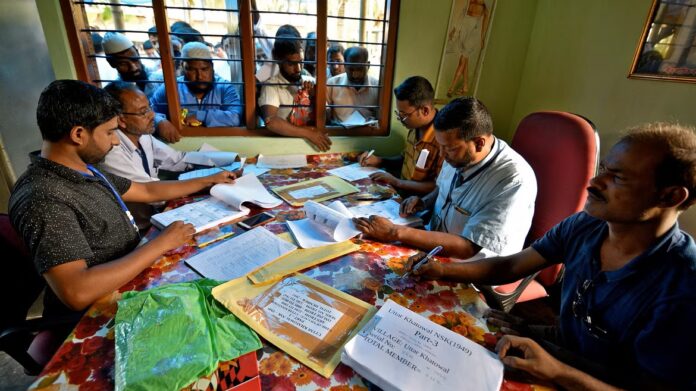Assam, located in the northeastern part of India, has long been a focal point in the country’s immigration debate. Known for its ethnic diversity, the state has also seen tensions arise over issues of illegal immigration, particularly from neighboring Bangladesh. In a report spanning over four decades, a startling revelation has come to light: 47,928 individuals were declared as foreigners in Assam between 1980 and 2023. Notably, 43% of them were Hindus.
This discovery is part of a larger narrative surrounding the citizenship debate in Assam, where concerns about illegal immigration have sparked political, social, and demographic changes over the years. The data comes at a time when Assam and the rest of India have been engaged in intense discussions on citizenship, identity, and the rights of those deemed to be non-citizens.
The Historical Context
The issue of illegal immigration in Assam has its roots in colonial and post-colonial history. Since the British colonial era, there has been significant migration from what is today Bangladesh (formerly East Bengal and later East Pakistan) into Assam. Post-independence, migration continued due to factors such as poverty, religious persecution, and land shortages.
The most significant event in the state’s immigration debate came in 1979 with the beginning of the Assam Movement (1979-1985), led by the All Assam Students’ Union (AASU). The movement sought to expel illegal immigrants, particularly from Bangladesh, citing their impact on the state’s demography, resources, and indigenous culture. The Assam Accord, signed in 1985, was a direct outcome of this agitation. One of its key provisions was the detection and deportation of illegal immigrants who entered the state after March 24, 1971.
Since then, the Foreigners Tribunals (FTs) in Assam have been tasked with identifying individuals classified as illegal immigrants. These tribunals were set up under the Foreigners Act of 1946 to hear cases against suspected illegal foreigners.
The Statistics: 43% Hindus Detected as Foreigners
The recent report documenting 47,928 individuals declared as foreigners in Assam from 1980 to 2023 offers insights into the composition of those identified. Among the 47,928, an unexpected 43% of them were identified as Hindus, a figure that challenges the widely-held belief that illegal immigration in Assam is solely a Muslim issue.
This statistic is significant for several reasons. Firstly, it highlights the complex religious and ethnic dynamics of migration in the region. The popular discourse often frames the illegal immigration issue in Assam as primarily concerning Bengali-speaking Muslims from Bangladesh. However, the fact that 43% of those declared foreigners are Hindus reveals a broader picture. Hindu migrants from Bangladesh have entered Assam over the years, driven by a range of factors such as economic migration, land shortages, and communal violence in Bangladesh.
It’s important to note that Assam’s neighboring country, Bangladesh, has witnessed significant upheavals post-independence, including the 1971 Liberation War and subsequent political and economic turmoil. Many Hindus fled Bangladesh in the decades following the country’s independence, and Assam, due to its proximity and historical ties, became a natural destination for some of these migrants.
Citizenship Amendment Act (CAA) and Its Implications
The data raises questions in the context of India’s recent Citizenship Amendment Act (CAA), passed in 2019. The CAA provides a pathway to Indian citizenship for non-Muslim minorities (including Hindus) from Pakistan, Bangladesh, and Afghanistan who entered India before December 31, 2014. The law has been controversial, with critics arguing that it discriminates on religious grounds and undermines the secular ethos of India’s Constitution.
In Assam, the CAA sparked widespread protests, with many fearing that it would legitimize the presence of Hindu migrants while excluding Muslims. The revelation that 43% of the detected foreigners were Hindus adds another layer to the debate. These individuals, many of whom may have entered Assam decades ago, could potentially benefit from the CAA if they meet the cutoff criteria, leading to concerns about how the law intersects with the state’s own citizenship verification processes.
The National Register of Citizens (NRC)
Assam has also been at the center of India’s National Register of Citizens (NRC), which aims to identify genuine Indian citizens and weed out illegal immigrants. The updated NRC was published in August 2019, but it has been mired in controversy due to alleged errors and exclusions. Over 1.9 million people in Assam were left out of the NRC, leading to uncertainty about their future.
The revelation that a significant proportion of those declared foreigners are Hindus complicates the state’s efforts to resolve the citizenship question. It shows that migration to Assam has affected various religious communities and that any solution must account for the broader demographic landscape.
The detection of 47,928 foreigners in Assam over the past 43 years, with 43% of them being Hindus, challenges the conventional narratives surrounding illegal immigration in the state. It highlights the multifaceted nature of migration in Assam, where both religious and ethnic identities have played a significant role. As Assam continues to grapple with the twin issues of illegal immigration and citizenship, the data underscores the need for a nuanced approach that considers the complexities of the region’s history, demography, and politics.




